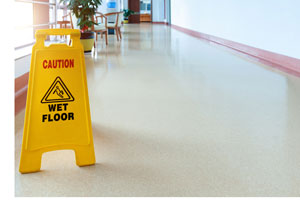25 steps for a safer office

It’s fairly obvious that safety and health hazards can exist on worksites filled with heavy machinery and equipment. The office setting is also fraught with dangers — from slips and falls to computer eye strain.
Many of these hazards are also quite obvious, but we’ll point them out anyway.
- Clutter: Boxes, files and other items piled in walkways can create tripping hazards.
- Standing on chairs, particularly rolling office chairs, to reach something is a significant fall hazard. Invest in a step ladder.
- Blind corners in hallways: Consider installing convex mirrors at these intersections.
- Slick marble or tile walkways: Cover with carpeting and other skid-resistant surfaces, particularly at inside entrances.
- Shut the drawer: File cabinets with too many fully extended drawers could tip over; they also pose tripping hazards
- Safe stacking: Heavier items go on the bottom, making it less likely for the stack to fall over.
- Adjustable equipment: One size does not fit all in an office workstation. You’ll have fewer ergonomics issues if chairs, monitors and work surfaces are adjustable.
- Employee training: Make sure everyone knows how to use the adjustable equipment.
- Feet on the floor: Unless an employee’s feet are on the floor, an ergonomic chair will not be able to reduce pain and discomfort.
- Document holders: They will reduce neck strain if the employee must look from the document to the computer frequently.
- Correct mouse placement: The mouse should always be next to and on the same level as the keyboard.
- Dim the lights and use task lamps with recessed lightbulbs: Florescent lights in office buildings often are too bright for optimal vision.
- Computer monitor position: The correct position is slightly below eye level and 20-26 inches from the eyes.
- Curtains or blinds: They minimize screen glare caused by open windows.
- Eyeglasses: Corrective lenses are available for computer use that allow the wearer to see the full monitor without neck strain.
- Computer font size: Make it large enough to help prevent both neck and eye strain.
- Breaks: A 10-minute break for every hour on the computer reduces eye strain and fatigue.
- Electric cords: Keep them in good repair; don’t overload outlets.
- Space heaters: Verify the devices are approved for commercial use and have a switch that automatically shuts off the heater if it is tipped over.
- Fire sprinklers: Don’t block with furniture or tall stacks of materials.
- Escape routes: Don’t block them or prop open fire doors.
- Double check: Conduct periodic walk-throughs to look for hazards and to maintain ergonomic task design.
- Be alert: Monitor signs of musculoskeletal disorders.
- Talk: Make sure employees can talk to supervisors about their concerns.
- Reporting systems: Establish ways for employees to report safety
Source: Safety+Health
From identifying noise hazards to helping you establish safety standards, we’re pros at helping you create a safer work environment.
Email Jennifer Hill, OCCMed director.

